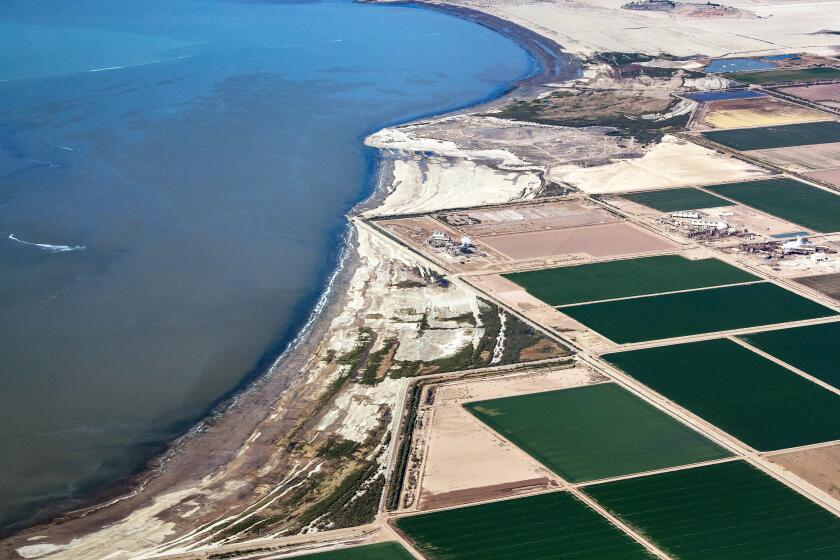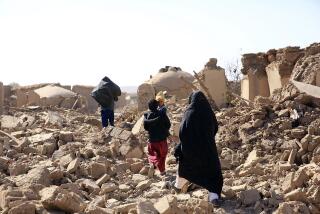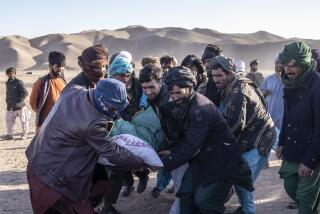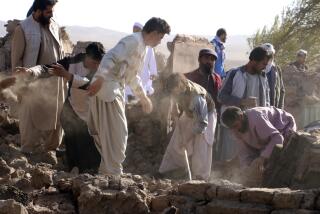Powerful quake in Morocco kills more than 2,000, topples homes and historic buildings in Marrakech
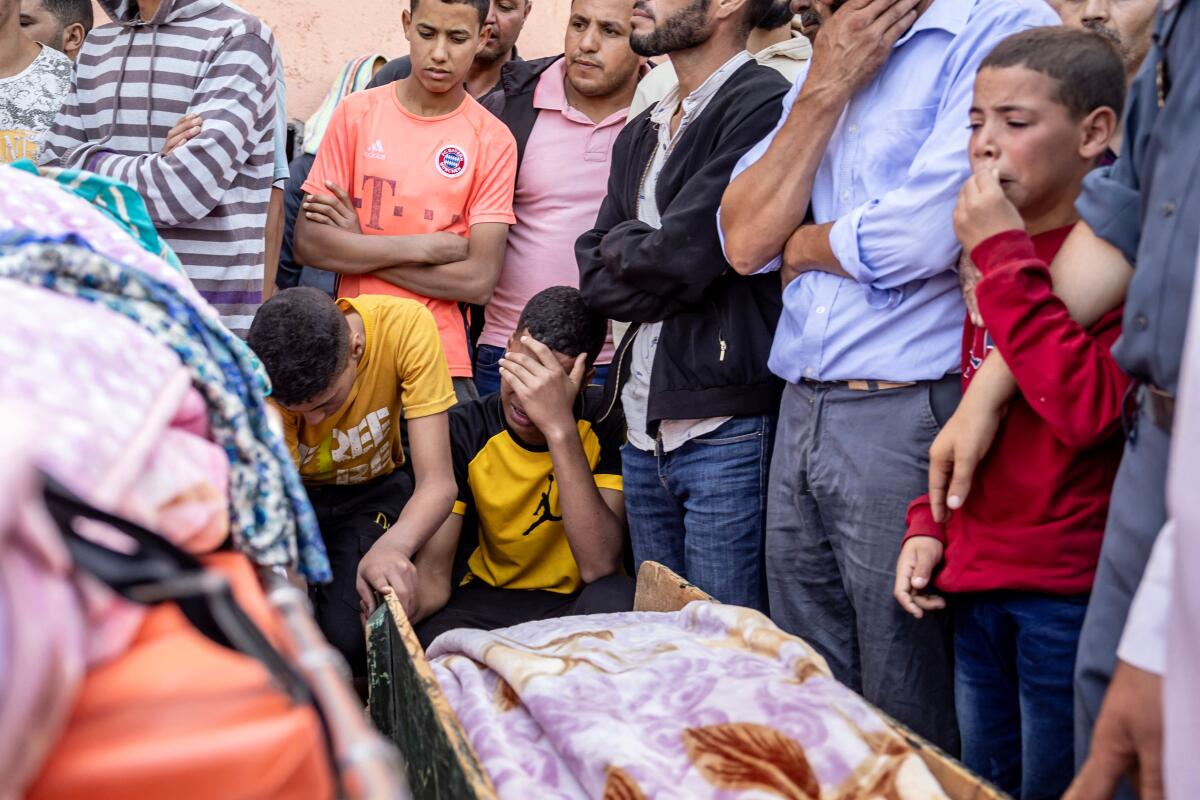
- Share via
MARRAKECH, Morocco — A rare, powerful earthquake struck Morocco, killing more than 2,000 people and toppling or seriously damaging buildings in a swath of destruction stretching from villages in the Atlas Mountains to the historic city of Marrakech. The toll was expected to rise as rescuers struggled Saturday to reach hardest-hit remote areas where the dead were laid to rest even as desperate efforts were underway to save those trapped.
People woken late Friday by the magnitude 6.8 quake ran into the streets in terror and disbelief. A man visiting a nearby apartment said dishes and wall hangings began raining down, and people were knocked off their feet and chairs. A woman described fleeing her house after an “intense vibration.” A man holding a child said he was jarred awake in bed by the shaking.
The quake, the biggest to hit Morocco in 120 years, brought down walls made from stone and masonry not constructed to endure quakes, covering whole communities with rubble and leaving residents picking their way precariously through remains. Rescuers worked through the night to find survivors buried in the dusty ruins.
A tent typically used for celebrations was erected for shelter in the center of the impoverished mountain community of Moulay Brahim, where homes made of clay and brick were largely left uninhabitable. Fathers sobbed into phones telling loved ones about losing their children. Bodies covered with blankets lay in the health center next to a mosque as doctors pulled shards from survivors’ feet and treated surface wounds.
“There’s nothing to do but pray,” said Hamza Lamghani, who lost five of his closest friends.
State television showed people clustered in the streets of Marrakech, afraid to go back inside buildings that might be unstable. Many wrapped themselves in blankets as they tried to sleep outside.
In Marrakech, the famous Koutoubia Mosque, built in the 12th century, was damaged, but the extent was not immediately clear. Its 226-foot minaret is known as the “roof of Marrakech.” Moroccans also posted videos showing damage to parts of the famous red walls that surround the Old City, a UNESCO World Heritage site.
At least 2,012 people died, mostly in Marrakech and five provinces near the quake’s epicenter, and 2,059 more people were injured, 1,404 critically, Morocco’s Interior Ministry reported Saturday.
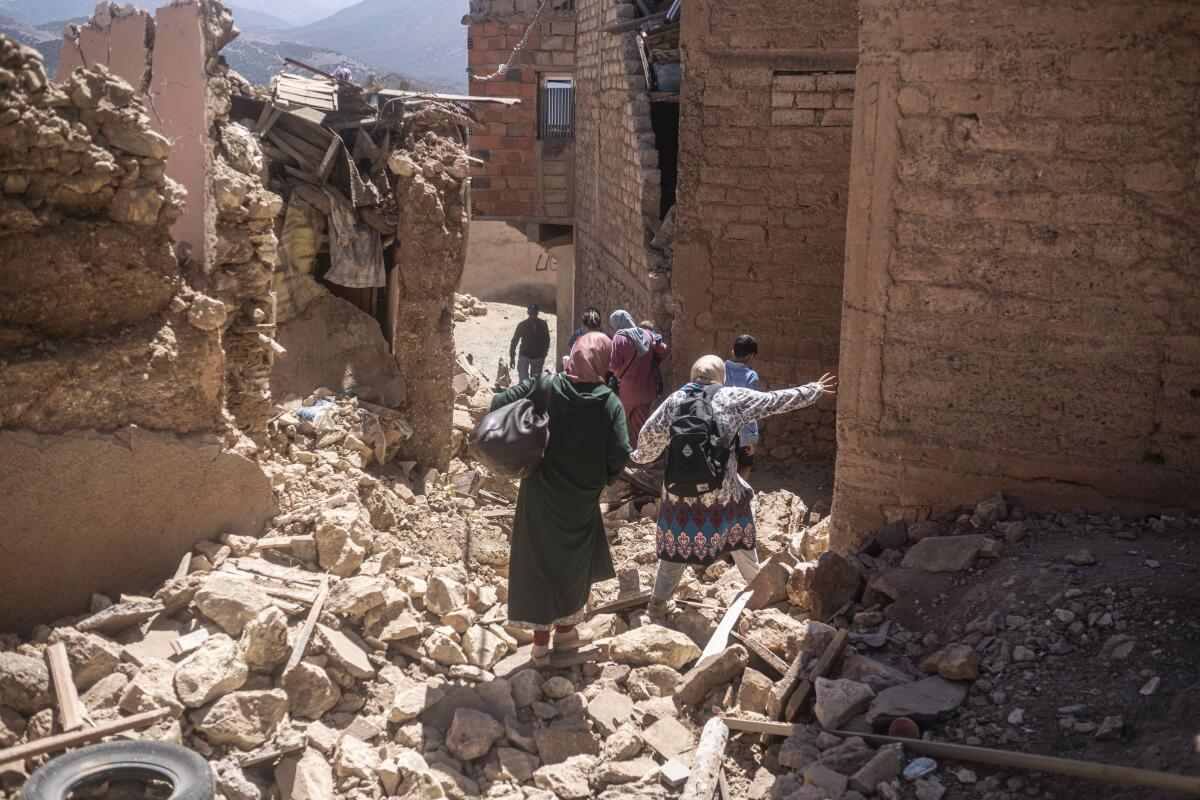
“The problem is that where destructive earthquakes are rare, buildings are simply not constructed robustly enough to cope with strong ground shaking, so many collapse resulting in high casualties,” said Bill McGuire, professor emeritus of geophysical and climate hazards at University College London. “I would expect the final death toll to climb into the thousands once more is known. As with any big quake, aftershocks are likely, which will lead to further casualties and hinder search and rescue.”
In a sign of the huge scale of the disaster, Morocco’s King Mohammed VI ordered the armed forces to mobilize air and land assets, specialized search-and-rescue teams and a surgical field hospital, according to a statement from the military. Despite an outpouring of offers of help from around the world, the Moroccan government has not formally asked for assistance, a step required before outside rescue crews can deploy.
A drying Salton Sea may be helping delay the next Big One, but that could result in a more powerful quake when it does strike.
Most of the tiny village of Moulay Brahim, carved into a mountainside south of Marrakech, was uninhabitable after walls crumbled, windows shattered and more than a dozen homes were reduced to piles of concrete and bent metal poles. At least five residents were trapped.
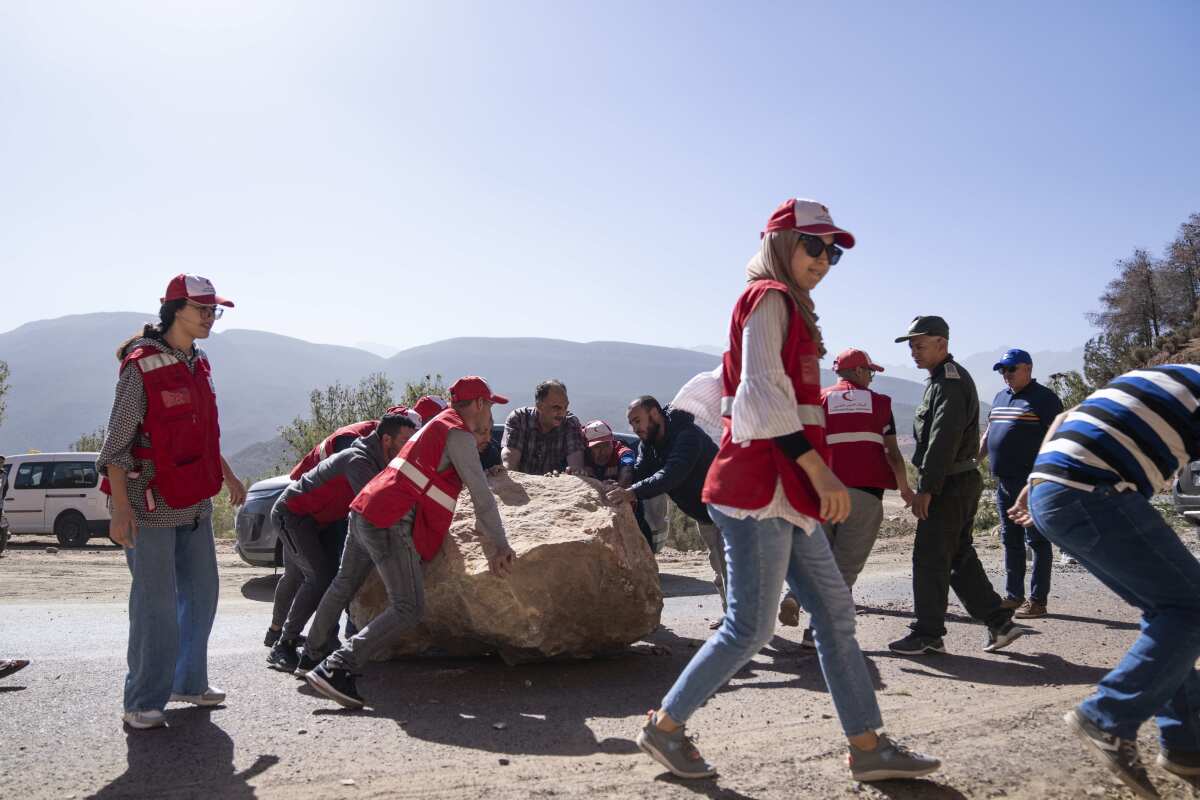
Ayoub Toudite said he had been working out with friends at the gym when “we felt a huge shake like it was doomsday.” In 10 seconds, he said, everything was gone.
“We found casualties and people running and kids crying,” he told the Associated Press. “We never saw anything like this — 20 deaths in the area, 30 injuries.”
Rescuers were using hammers and axes to free a man trapped under a two-story building. People capable of squeezing into the tiny space were giving him water.
Ojai residents faced Tropical Storm Hilary and an earthquake all in the same afternoon. The result? Not much damage, lots of “hurriquake” comments.
“We are all terrified that this happens again,” Toudite said.
The head of a town near the earthquake’s epicenter told Moroccan news site 2M that several homes in nearby towns had partially or totally collapsed, and electricity and roads were cut off in some places.
The epicenter of Friday’s tremor was near the town of Ighil in Al Haouz province, roughly 44 miles south of Marrakech. Al Haouz is known for scenic villages and valleys tucked in the High Atlas Mountains.
Abderrahim Ait Daoud, head of the town of Talat N’Yaaqoub, said that authorities were working to clear roads in Al Haouz province to allow passage of ambulances and aid, but that the large distances between mountain villages meant it would take time to learn the extent of the damage.
The Moroccan military deployed aircraft, helicopters and drones, and emergency services mobilized aid efforts to the affected areas, but roads leading to the mountain region around the epicenter were jammed with vehicles and blocked with collapsed rocks, slowing rescue efforts. Trucks loaded with blankets, camp cots and lighting equipment were trying to reach the hard-hit area, the official news agency MAP reported.
Japan’s prime minister takes part in a televised earthquake disaster drill on the 100th anniversary of a temblor that devastated the Tokyo region.
On the steep and winding switchbacks from Marrakech to Al Haouz, ambulances with sirens blaring and cars with their horns honking veered around piles of Mars-like red rock that had tumbled from the mountainside and blocked the road. Workers tried to clear away a boulder blocking the two-lane highway.
Later Saturday morning in Marrakech, ambulances and motorcycles whirred by the edge of the Old City, where business as usual had mostly resumed. Tourists and passersby navigated roadblocks and snapped photos of sections of the clay ocher wall that had cracked, spilling fragments and dust onto the sidewalk and street.
World leaders offered to send in aid or rescue crews as condolences poured in from countries around Europe, the Middle East and a Group of 20 summit in India. Turkey’s president, whose country lost tens of thousands of people in a massive earthquake earlier this year, was among those offering assistance. France and Germany, both with large populations of people with Moroccan origins, also offered to help, and the leaders of Ukraine and Russia expressed support for Moroccans.
In an exceptional move, neighboring rival Algeria offered to open its airspace to allow eventual humanitarian aid or medical evacuation flights to travel to and from Morocco. Algeria closed the airspace when its government severed diplomatic ties with Morocco in 2021 over a series of issues. The countries have a decades-long dispute involving the territory of Western Sahara.
The U.S. Geological Survey said the quake had a preliminary magnitude of 6.8 when it hit at 11:11 p.m. Friday, with shaking that lasted several seconds. The agency reported that a magnitude 4.9 aftershock hit 19 minutes later. The collision of the African and Eurasian tectonic plates occurred at a relatively shallow depth, which makes a quake more dangerous.
Breaking News
Get breaking news, investigations, analysis and more signature journalism from the Los Angeles Times in your inbox.
You may occasionally receive promotional content from the Los Angeles Times.
The U.S. Geological Survey said the epicenter was 11 miles below the Earth’s surface, while Morocco’s seismic agency put it at seven miles down.
Initial reports suggested that damage and deaths were severe throughout the Marrakech-Safi region, which more than 4.5 million people call home, according to state figures.
Earthquakes are relatively rare in North Africa. Lahcen Mhanni, head of the Seismic Monitoring and Warning Department at the National Institute of Geophysics, told 2M TV that the earthquake was the strongest ever recorded in the region.
In 1960, a magnitude 5.8 temblor struck near the Moroccan city of Agadir and caused thousands of deaths.
The Agadir quake prompted changes in construction rules in Morocco, but many buildings, especially rural homes, are not built to withstand such quakes.
In 2004, a magnitude 6.4 earthquake near the Mediterranean coastal city of Al Hoceima left more than 600 dead.
Friday’s quake was felt as far away as Portugal and Algeria, according to the Portuguese Institute for Sea and Atmosphere and Algeria’s Civil Defense agency, which oversees emergency response.
More to Read
Sign up for Essential California
The most important California stories and recommendations in your inbox every morning.
You may occasionally receive promotional content from the Los Angeles Times.
